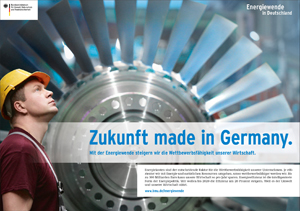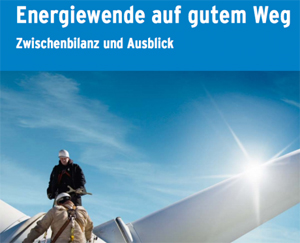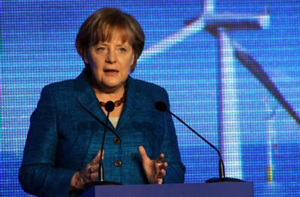Germany's stalled energy transition: waiting for the master plan
on
Germany's stalled energy transition: waiting for the master plan
The Merkel government's "energy revolution" was hailed across the political spectrum in Germany as an inspired step forward. But after a forceful start following the Fukushima disaster, the Energiewende has stalled, partly as a result of internal bickering but also because of the tremendous challenges involved in its implementation. Critics are calling on the government to come up with a master plan that will show how the Energiewende's ambitious targets can be met. "Where we want to be is in black and white. The problem is how to get there", notes one German expert. The world is watching for the next moves from Berlin.
 |
| The goverment's campaign of the "Energiewende" (bmu.de) |
During two weeks of Arctic winds and sub-zero temperatures this February, Germany's energy transition got perhaps its biggest boost since the Merkel administration pulled the plug on nuclear energy and embraced a future based on renewables. Merkel's critics, especially the owners of the country’s nuclear power plants and grid operators, had warned of blackouts and skyrocketing prices in the winter. None of these dark prophecies came true. Actually, during the cold spell, fueled by the winds on the Baltic coast and clear, sunny days in the south, Germany ended up exporting electricity to France, even though its grid was pushed to its limits (and though Germany did have to import electricity in the summer). Moreover, greenhouse-gas emissions fell 2.1 percent in 2011, despite the loss of the emissions-free nuclear sources and the burning of more brown coal in order to compensate. (It was because less energy was used and milder temperatures.)
These were modest victories for the Energiewende (energy transition), momentum upon which the Merkel administration could have built. Yet, after an initial flurry of new legislation in 2011, Germany's much-touted energy transition has stagnated and, many observers say, even wandered from course. No one questions the goals of the Energiewende (see box: "Germany's energy transition"), but many wonder how the government is going to achieve them.
"Where we want to be and when we want to be there is in black and white," Stephan Kohler, Chief Executive of the German Energy Agency (DENA), a think tank close to the government, tells EER. "The problem now is how to get there. We're still waiting for an overall master plan from the coalition."
This criticism is echoed by an array of actors in the transition, from Germany's EU energy commissioner, Günther Oettinger, a member of Merkel's party, to many private sector companies, including the big four RWE, Eon, Vattenfall and ENBW, who seem increasingly eager to jump into the renewable energy market. They are all increasingly frustrated with the transition's sluggish pace, a result of intense bickering in the ruling coalition.
Action plan
In the 2011 aftermath of the Merkel administration's u-turn on nuclear energy and proclamation of the Energiewende, the government was granted a short honeymoon period by opposition parties, energy producers, and environmental groups, among others involved in the process. But since early this year critical voices, including in industry and within Merkel's own party, have grown much louder.
Philipp Vohrer, director of the Agency for Renewable Energies (AER) in Berlin, a research institute sponsored by federal government ministries and energy producers, echoes the criticism of Kohler: "What's lacking is an overall action plan to move the energy transition as whole forward", he tells EER.
| "What's missing right now is project management" |
All of the opposition parties - the Greens, Social Democrats, and the Left Party - have fiercely criticized the coalition's indecision and have increasingly questioned its commitment to the transition. Green Party co-leader Jürgen Trittin said: "You can't just exit, you have to enter." The Greens argue that Germany's 2020 targets for renewable energy could be considerably more ambitious. Trittin also blasted the lack of vision: "The government has failed to explain how it will plug the gap between the shuttered reactors and targets for renewables."
Other vocal critics are the federal states (Länder), which have often driven energy policy forward in the absence of federal action. The country's 16 federal states are integral to the transition, active players and not just passive implementers of federal policy. For them the energy transition means new industry, tax revenue, and jobs. Even the Christian Democrat-run states weighed in against the cuts in solar subsidies made by the Merkel government, so important to the new solar industry in their states and jobs. In the course of the past year, five major solar companies have declared bankruptcy, several of them in eastern Germany where they constituted an important source of revenue for economies still grappling with the fallout of unification. One major bone of contention between the federal government and the states is who will pay for energy efficiency incentives.
The Merkel government in turn sniped back that the Länder aren't doing their share. It has urged the
| "You can't just exit, you have to enter" |
'To do' list
Observers agree that in addition to having to come up with an overarching implementation plan, the government's urgent 'to do' list is formidable. It includes, among others:
- refashioning the electricity grid
- solving the electricity storage conundrum
- redesigning energy market incentives, and
- making up ground to hit efficiency targets
Without progress on these issues, merely boosting the quantity of renewable energies in the German mix will have limited meaning. Yet progress has been severely hobbled by divisions within Merkel's coalition government, in particular between the bespectacled, 46-year-old environment minister Norbert Röttgen, and the powerful minister of economics, Philipp Rösler, who is also leader of the free-market Free Democrats, the coalition's junior partner.
Rösler's party, which has fared poorly in a string of recent elections, is straining to make its mark on coalition policy to win back voters. When it comes to the Energiewende, it is the least enthusiastic of the nation's political parties.
Sparks flew inside the coalition earlier this year when Rösler baulked at falling in line with the European Commission's proposed energy efficiency directive.
On top of that, the Free Democrats took issue with the feed-in tariff (FIT) rate for solar energy. The state-guaranteed rate has been declining for years, inching closer to market parity as the price of solar hardware dropped and technology improved. Early in 2012, the coalition accelerated the FIT's reduction, leaving it within reach of market parity for the first time. But Rösler insisted that it be slashed further. In the end the coalition agreed to increase cuts in solar power subsidies by 20 to 30 percent, though not quite as quickly as Rösler had wished. The decision sent shares in solar companies tumbling and even brought demonstrators, including solar industry workers, onto the streets to protest the cuts.
Big-ticket items
 |
| Last February the "Bundesumweltministerium" came up with an intermediate outlook of the Energiewende (pdf) |
The Grid: The government's biggest challenge is the need to reconfigure and expand the power grid to accommodate both the current renewable power being fed into it, and that which is scheduled to come onto the system in the course of coming decades.
In 2011, in the wake of Fukushima, the government passed the Grid Expansion Acceleration Act, which put more of the decision-making power concerning grid expansion into the hands of the central government (and less in the federal States or Länder) in order to expedite the process. If Germany is really to double its output of renewables by 2020, it will have to lay an estimated 3600 kilometers of new high-voltage transmission lines across the country. The priority of this enhanced network will be to carry electricity generated by North and Baltic Sea off-shore wind turbines to Germany's industrial hubs deep in the south. According to a study from consultancy Trendresearch, until 2022 some €6.1 billion will have to be invested in expansion of the supraregional high-voltage network and some €16.8 billion into the regional distribution networks. Until 2030 €10.5 billion plus €29 billion is needed.
Proposals are currently being formulated by Germany's grid operators, which will then be reviewed and finalized by the Federal Network Agency, which belongs to the portfolio of the Economics Ministry. The proposals will come before the Bundestag for parliamentary debate; a government decision on at least some of the main grid issues is expected in the autumn.
But a decision is not just a question of money - there are a number of knotty issues to be addressed. Will it be a more centralized or a more decentralized grid? According to which calculations of energy supply (looking far into the future) will the new grid be constructed? What relation will the new grid have to neighboring countries and maybe even an all-EU inclusive grid? Will the transmission cables be built predominantly overland or underground? What localities will become home to the unsightly 70-meter-high transmission towers and their cables? Who will bear the costs? What is a reasonable timeframe to expect their completion?
All of these questions are up in the air and, even in a best case scenario, only some of them will be answered definitively by the year's end.
Electricity Storage: New and new kinds of storage facilities will also be imperative to accommodate the fluctuations inherent in renewable energy sources, particularly wind and solar. This year alone Germany is sinking €200 million into R&D on storage options through the Federal Ministry of Education and Research, one of several of the federal ministries involved in energy policy. "Exploring storage technologies and bringing them to full maturity for industrial applications is a strategic task which is indispensable if we want our energy transition policy to work", Röttgen said in March. Yet the Federal Environment ministry (BMU) acknowledges that there is no easy answer to the problem. So far, Germany hasn't put all of its chips on one option; indeed there are a bewildering array of storage possibilities that are receiving funding, which shows just how wide open the field still is - and how distant a solution might be.
The most efficient, cheapest, and today the only technologically mature means of electricity storage is the pumped-storage of hydroelectricity. (Pumped-storage uses surplus electricity to pump water into elevated reservoirs. When electricity is needed, the water flows back down through channels and drives turbines to produce more electricity.) But experts say there is little hope of expanding it beyond its present capacity in light of Germany's limited space, topography, and population density. The one pumped storage plant currently under construction is in the Black Forest where the local population has taken to the streets to block it.
Thus monies are flowing into research in lithium and redox flow batteries, heat pumps, electric double-layer capacitors, and the coordination of networks of smaller, decentralized storage centers.
And then there's the hydrogen option, a technology with enormous potential that's been "right around the corner" now for three decades. Hydrogen (and methane, too) can absorb energy in compressed or liquid form, and then re-release it as electricity. There's great hope that underground hydrogen storage in caverns, salt domes, and depleted oil and gas fields will soon be viable.
Another option is thermal energy storage, which today includes the production of ice, and chilled or hot water, which is then used to cool/heat during the day. Thermal energy can be accumulated from active solar collectors or combined heat and power plants, and transferred to insulated repositories for later use in various applications, such as space heating, domestic heating, or process water heating.
There is currently no timetable for resolving the storage conundrum, and indeed Matthias Kurth, the former director of the Federal Network Agency, has warned against underestimating the task. "Things
| "Things that might be accomplished in decades are today regularly spoken about as if they could already function by next Friday" |
Philipp Vohrer of the AER cautions about postponing the expansion of renewables until a storage solution is in sight. "They aren't mutually exclusive", he says. "If the electricity grid is updated to handle more renewables sources, then part of the storage problem is already solved. We have to pursue both the expansion of renewable energies and the storage question at the same time."
Energy Efficiency: Dramatically improved efficiency, particularly in commercial, public, and residential buildings, is also key to Germany hitting its ambitious climate and Energiewende targets. But the Rösler-Röttgen tiff over the EU directive was just the tip of the iceberg in terms of disagreements between them over efficiency issues.
The implementation of energy efficiency measures - insulation, heat pumps, intelligent building technologies, efficient lighting systems - is falling ever further behind schedule, despite unequivocal evidence of its long-term benefits to consumers: "Anyone who refurbishes their house without improving its energy efficiency is missing a golden opportunity," says DENA's Kohler. "Owners have to make an investment one way or the other. It's their choice: refurbish properly once with energy-saving measures, or pay high heating bills, which will probably even increase, for years." The environment ministry estimates that 40 percent of the energy Germans use is for heating their homes.
But despite this convincing logic, home owners are not biting at the incentives. The costs of insulating and other measures can run into the tens of thousands of euros and the existing state incentives, like low-interest loans, which are provided by the investment bank of the federal government, simply do not offset those costs sufficiently for most homeowners to make the investment. The only solution, according to Kohler, is "better, bigger incentives."
Moreover, much of the funding to help refurbish buildings has failed to materialize from its intended source, the Energy and Climate Fund, which is largely financed from the auctioning of CO2 certificates. In 2012, prices in the carbon markets slumped and resulted in significantly less sales of CO2 certificates. In March, the finance ministry thus reallocated funds from other sources totaling €452 million for 2012. Proposals for further tax deductions for building renovations are under discussion, as is increasing the market incentive for the use of renewable energies for heat generation in buildings.
Yet critics say the finance ministry's monies are just a drop in the bucket of what is really needed. "Four hundred million is really nothing," says Lars Brischke, an energy efficiency specialist at the Institute for Energy and Environmental Research in Heidelberg, to EER. "In order to meet the targets of renovating 2 to 3 percent of buildings a year, Germany would require three to four billions euros, at least." Kohler of DENA uses the figure of five billion euros.
Energy Market Incentives: Arguably, the government's most important initiative this year has been the introduction of the so-called market premium. This amendment to the Renewable Energy Sources Act (EEG) is widely considered a first step toward reconfiguring energy market incentives to correspond to the current, changing energy market in Germany.
 |
| 'The world is watching Germany's Energiewende' (solarladen.de) |
The purpose of the new law is to turn producers of renewable energy electricity into market players who optimize production according to market prices. The way the market premium is designed, it adds value to production which meets the energy demands of the system rather than just produces energy according to weather conditions.
Whether this initiative has actually been successful, though, is not entirely clear. Although many wind turbine operators, in particular, have opted to take the premium over the feed-in tariff rate, it has not made electricity cheaper. In fact, many wind producers have benefited financially from the new regulation, which they originally opposed and was forecast to cut into their revenues.
But many observers say that the entire German incentive system, which was essentially established 12 years ago, when the EEG was first passed in 2000, needs to be revamped. "The incentives we have today were set for an energy market with just a tiny fraction of renewable energies and when they had no chance on the market at all", explains Kathrin Goldammer, Project Manager of the Transdisciplinary Panel on Energy Change, a research project at the Institute for Advanced Sustainability Studies in Potsdam. "Now the market looks much different and there are new priorities. The incentives policy should be abolished eventually or changed to fit the present energy markets and Germany's needs."
Epic proportions
One of those needs, she and others like Matthias Kurth argue, is new, state-of-the-art gas-fired power plants that will back up an energy market in which renewables have priority. The problem is that there are few interested investors in gas plants that function as back-up for renewables, especially when renewables have pushed electricity prices down as low as they have. "There is no profit for anyone there", says Goldammer, "because the price differential between the costs of natural gas and the electricity prices on the market is steadily decreasing. So there are going to have to be other incentives to build them."
Many gas-fired plants operated at a loss in 2011 and some even closed their doors altogether, like the Norwegian-run Statkraft SF, a Norwegian power generator in the German city of Emden near the Dutch border.
Observers call Germany's Energiewende an endeavor on a scale with Germany's unification or the U.S. space program. Indeed fueling Germany's energy-intensive economy with renewables alone is a challenge and experiment of epic proportions. But for it to succeed, Germany needs more than high-flying goals. Some critics have suggested a special ministry, or at least a federal office, dedicated to coordinating the energy transition. Others say that it's going to take a new government to take the necessary steps to drive it forward. Whatever the case, Germans aren't the only ones waiting for a more pro-active policy. The world is watching Germany's Energiewende.
|
Targets of the German Energy Transition
|


Discussion (0 comments)